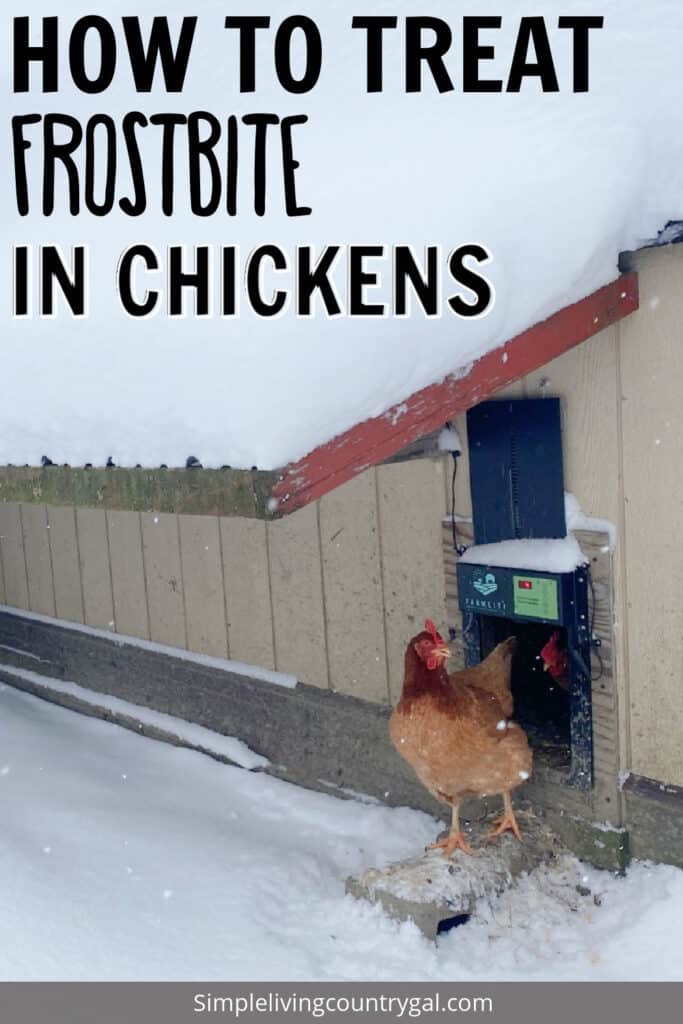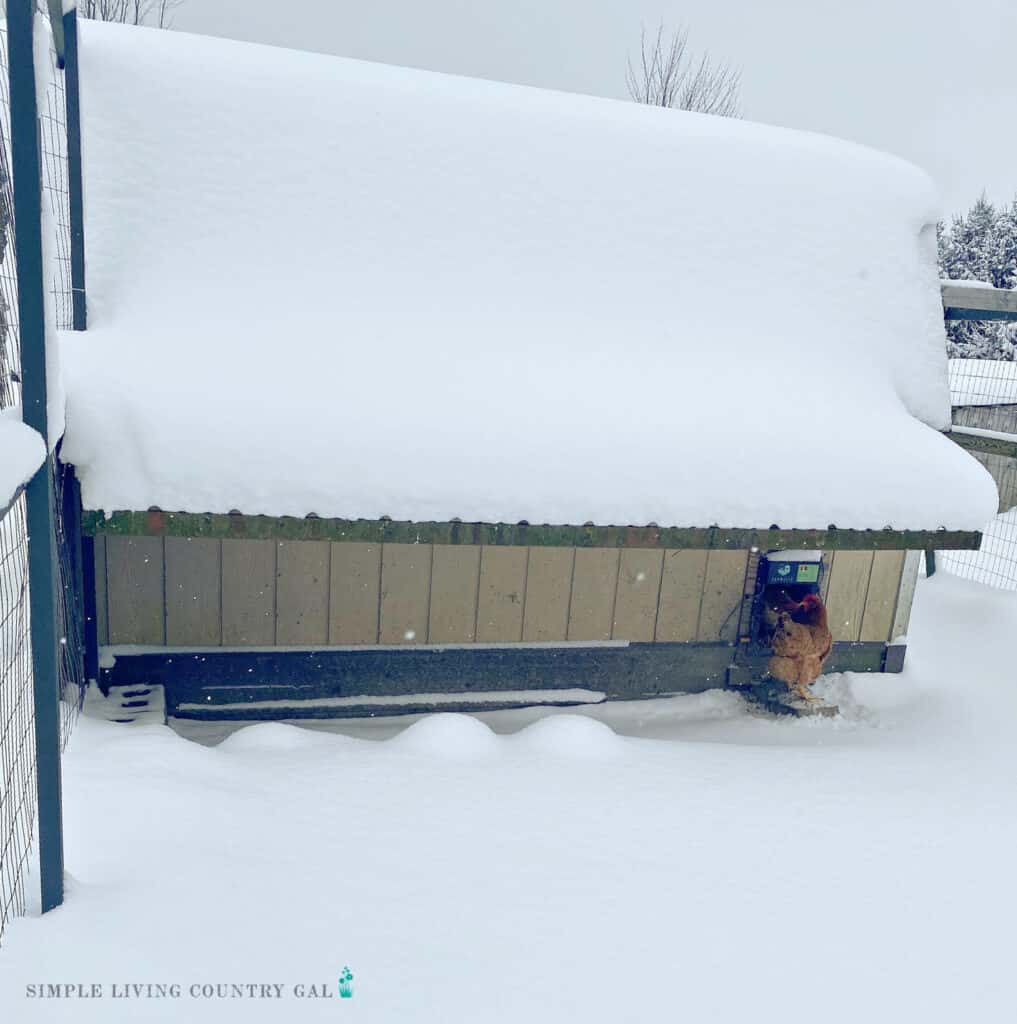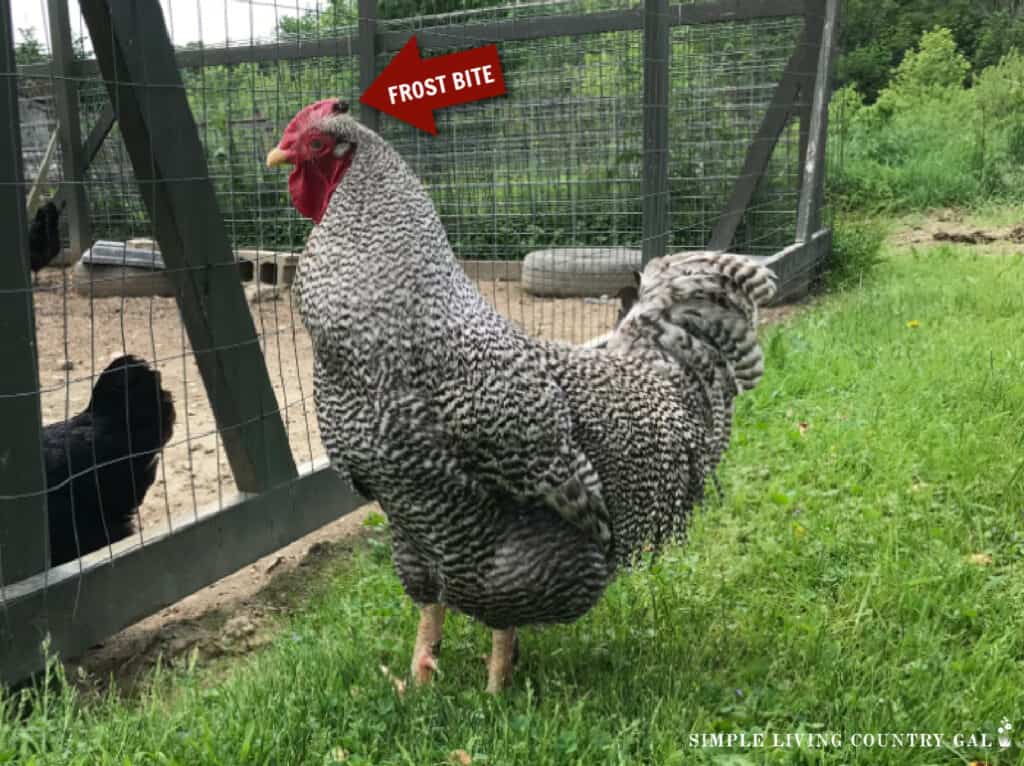Treating Frostbite in Chickens
Winters can take it toll of people and their animals causing issues with our flock. To help we have tips on treating frostbite in chickens so you can help your hens and roosters cope.
Raising chickens that are healthy and intervening when they need help especially in the winter.
Be sure to grab the FREE Chicken Coop Checklist below!

Chickens can do quite well in the winter. If given the time to acclimate to the changing temperatures they will grow all the feathers they need to stay warm. There are a few areas that are not protected and can get frostbite if they are exposed too long and that is their feet, wattles, and combs.
Knowing how to protect against frostbite and what you can do to treat cases as they come up will help your flock weather the winter.
Can chickens get frostbite?
Yes, chickens can get frostbite. It is a common issue that affects many animals during the winter months. Frostbite occurs when body tissues are exposed to extreme cold temperatures, causing ice crystals to form and damage the cells. While chickens are generally hardy birds, they can still suffer from frostbite if not given proper protection in harsh weather conditions.

The importance of prompt and proper treatment
If your chicken is experiencing frostbite, it is important to treat it promptly and properly. Failure to do so can result in permanent damage or even death for the affected bird. Additionally, a chicken with untreated frostbite will be more susceptible to future cases of frostbite, making them less able to survive in colder temperatures.
How to spot frostbite on chickens
The areas most prone to frostbite on chickens are their feet, wattles, and combs. These areas have less protection from feathers and are more exposed to the elements. Frostbite typically appears as pale, white or bluish areas on the skin. In severe cases, these areas may turn black due to tissue damage.

To ensure you catch things early, check your flock one by one at each feeding. Yes, this does take a bit of time but it will help keep everyone safer in the winter.
Treating frostbite in chickens
If you notice signs of frostbite on your chicken, it is important to give them care as quickly as possible.
- Remove the chicken from the flock and bring indoors if you are able.
- Wrap them in a warm dry towel helping their body to warm up more quickly.
- Gently and slowly warm frostbitten areas with a warm towel until the color returns.
- If their feet are affected, you can put them into warm water and slowly massage with your hands. Be sure not to use water that is too warm as this can cause pain.
- You can use a warm wet rag on the comb or wattles. This will help to warm up these areas more quickly. Use a gentle touch as you do so you don’t cause further injury to the affected areas.
Remember, never use direct heat sources such as hair dryers or heaters, as this can cause further damage to the affected area. Always be sure to go slow and steady for the safest treatment.
Chicken Water Heater 15 in for 5 Gallons Chicken Drinker, 125W Poultry Waterer Heated Base with Thermostat and 9.8ft Power Cord for Metal Drinking Fountains Chicken Coop


Preventing Frostbite With Housing
The best way to protect against frostbite in chickens is by providing adequate shelter that will help to keep them warm, dry, and protected from the wet and cold weather. Be sure it is free of drafts and has no openings that will let in wet or snow.
Bedding
An important part of a good winter shelter is bedding. We like to have at least 5-6 inches of dry bedding on the floor to help protect their feet. We prefer to use a combination of wood shavings and straw on the ground because the wood will soak up any wetness and the straw will add a layer of warmth. If you live in a very cold area you may want to employ the deep litter method. This means adding fresh bedding routinely on top of the bedding you already have. The thickness is the best way to keep a coop warmer. You can read how to use the deep litter method here.
Storey’s Guide to Raising Chickens, 3rd Edition


Nesting Boxes
Fill nesting boxes with bedding such as straw or hay to help keep your egg layers warm and protect the eggs from freezing and cracking. You can also hang a rag over the opening of each nesting box that will act as a curtain helping the inside to stay warmer.
Read for more tips on how to keep eggs from freezing.
Insulate
Another helpful tip is to find ways to insulate the coop to help keep the inside warmer. You can use straw bales, empty feed bags, or dried leaves. Line the inside of the coop with bales and push empty feed bags down behind each bale. No, it’s not pretty but it works great.
Do Routine Checks
Set a routine of regularly inspecting the coop checking for drafts both high and low. Do spot cleanings inside of the coop to prevent moisture build-up. Add more bedding to wet areas giving a dry floor to walk on.
Other ways to prevent frostbite with chickens
Aside from providing adequate shelter, there are other things you can do to prevent frostbite in your chickens. These include:
- Limiting outdoor activities during extreme cold weather conditions.
- Adjusting feeding schedules to encourage more activity during warmer times of the day.
- Keeping water sources from freezing by using heated waterers or frequently changing out frozen ones.
- Apply salve to combs and wattles to protect from freezing.
- Provide good nutrition and vitamins to encourage a healthier flock.
Remember to do regularly checks of your chickens for any signs of frostbite and address them immediately. Prevention is always better than treatment when it comes to protecting your flock against harsh winter weather.
Frostbite in chickens can be a serious issue in a flock. Be sure to protect your chickens by providing adequate shelter, insulating the coop and nesting boxes, and doing routine checks of each member in your flock. If you do see signs of frostbite, remove and warm up any chicken that is affected. Follow these tips for treating frostbite in chickens and raise a flock that is hardy and healthy all winter long.








